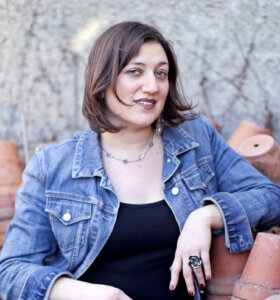Behold The Jewish Treasures Of The Library Of Congress

Library of Congress Image by Getty Images
I saw censor’s marks for the first time at the Library of Congress, home to a priceless collection of Hebrew books. I opened a 1486 edition of the machzor, a High Holidays prayer book labeled Minhag Roma, or Roman rite — printed in Italy, bound in marbled boards and featuring leather corners — and gasped at the censor’s marks, still visible in the famous Aleinu prayer, in a verse that refers to adherents of other faiths. I saw the censor’s signature; his name is still visible after all these centuries.
I don’t think I ever fully understood the idea of a government or church official censoring prayer until I saw it in a book that is more than 500 years old, and I have been thinking about it ever since. I’ve been thinking about the words I saw censored, like the phrase memshelet zadon, variously translated as “wicked regime,” “unlawful rule” and “tyranny.” It’s a chilling reminder of the world’s long history of religious oppression, and a tribute to the miracle of survival of the Jewish people. And it was interesting to think about it in light of current politics, when religion, national origin and language are once again under attack around the globe.
There are 23 Hebrew incunabula, or books published before 1501, in the Library of Congress’s collection in Washington, D.C. — accessible to all who fill out a small light-green book request form, like in the old days. These incunabula include a 1469 edition of questions and answers by the Rashba (1235–1310); the questions can seem contemporary, such as the one wondering if a community should hire a professional hazan or stick with a lay cantor. (Answer: Go professional so that you can tell him what to do.)
But there is also plenty of incredible material from the 20th century, such as newsletters from displaced persons camps, set up in the aftermath of World War II and sometimes written in Yiddish with Latin script. The Library of Congress was also the repository for Yiddish plays for decades, because playwrights sent them for copyright purposes; some are even written on onionskin. Strangely, finding out that Yiddish playwrights mailed their creations to Washington reminded me of finding out that Akkadian scholars sent their latest works to the office of the Chicago Assyrian Dictionary at the Oriental Institute of the University of Chicago, where they ended up in a closet. Both the playwrights and the scholars wanted a record; they wanted proof that they existed, that their works were there — at a time when the audience for their work was limited, and seemingly dwindling fast.

A poster for a Yiddish theater production in Chicago from the Library of Congress collection. Image by Library of Congress
But what did I want from the Library of Congress?
Everyone seems to want something from this gorgeous place, I realized as I watched my second school tour group pass while I leafed through the machzor. Several eighth-graders were wearing hats reading Make America Great Again, as the teacher addressed students in Spanish and English. Tourists want an experience, scholars want information they can’t find anywhere else, and genealogy-obsessed relatives sometimes come here as a last resort. I wanted to satisfy my curiosity about the holdings in Jewish languages at the Library of Congress. But the more I found, the more curious I became.
My initial idea was to try and figure out what a visitor off the street might be able to find with a little bit of patience in this magnificent building. I wanted to visit as a regular person, not as a journalist or a scholarly specialist. I had, of course, looked at the website before traveling to Washington, and so this description for the African and Middle Eastern Reading Room gave me some clue of what I would find:
“The Hebraic Section of the Library of Congress has long been recognized as one of the world’s foremost centers for the study of Hebrew and Yiddish materials. Established in 1914 as part of the Division of Semitica and Oriental Literature, its beginnings can be traced to Jacob H. Schiff’s gift in 1912 of nearly 10,000 books and pamphlets from the private collection of Ephraim Deinard a well-known bibliographer and bookseller.”
Though it’s clear that the library has an important collection, you really have to see it to believe it: There is simply nothing like seeing censor’s marks in front of your eyes.
Now for the basics. When it comes to Jewish materials, the African & Middle Eastern Reading Room houses only works published in Hebraic script, such as Yiddish, Ladino and Hebrew; for books on Jews written in, say, French or English, the place to go is the main reading room, which is one of the most gorgeous spaces on this earth a person can possibly read in.

The Washington Haggadah from the Library of Congress collection. Image by Library of Congress
For novices, navigating the Library of Congress isn’t easy. The hardest part of reaching the treasures in Jewish languages is finding two rooms: first, the exact spot to obtain a Reader Services identification card, and second, the actual room where Hebraic script treasures are found. Let’s summarize by saying that the ground floor of the library can be a cavernous place, but with the kindness of strangers I eventually managed to find the right elevator and the correct coat check. I showed photo identification, had my picture taken and was allowed to take a few personal items in a clear plastic bag. I put in a laptop, but I would have been fine with just a notebook.
Then the odyssey of locating the African & Middle Eastern Reading Room began. I had to go to a different floor, and cross to the other side of the building, and then, I had to pass through an exhibit on the early Americas. But the trip had its benefits, like seeing a copy of the Gutenberg Bible enclosed in glass. Really.
Looking up and down along the way is highly recommended. Looking up, I saw a magnificent ceiling that is impossible to believe unless you see it, along with statements like “Nature Is the Art of God” and “There Is No Work of Genius Which Has Not Been the Delight of Mankind.” The floor mosaics are breathtaking too. But my personal favorite moment was this line, featured above: “Knowledge Comes but Wisdom Lingers.”
That was my hope for this pilgrimage: I wanted to see what had managed to linger, despite the passing of the centuries.

From The WWI War Effort: ‘Britain Expects Every Son Of Israel To Do His Duty,’ a 1918 poster avers. Image by Library of Congress
After looking through the reference shelves, which feature books like The Oxford Dictionary of the Jewish Religion and “Everyday Life in Babylon and Assyria” along with lexicons of languages related to Hebrew, such as Aramaic, Assyrian and Syriac, I asked to speak to the librarian. She very kindly brought me the three books I had requested — a 1490 edition of volumes by Maimonides, titled the Mishneh Torah or Yad Hazaka (The Strong Hand); an artist’s book made of the Book of Lamentations, and another artist’s rendering of the Book of Ruth. She also brought a fourth: the machzor in which I glimpsed the censor’s marks. But it’s important to note — for librarian requests, it is certainly best to make contact in advance.
The Maimonides classic, bound in two volumes in what the official guide describes as “identical light grey boards with hand-written titles on the spine in large black letters,” had no table of contents, and in many ways it was similar to a scroll — just in printed-book form; but it was still a deep thrill to see a version that is over 500 years old.
The artists’ book collection is especially fascinating and includes books made in editions of only 18 copies. There are several artists’ renditions of Genesis and Exodus and a translation of Chinese into Hebrew. I marveled at the barley covered sack that contained a rendering of the Book of Ruth, with brown silk ribbons tying it closed. The artist, Tamar Meser, made this book — number 32 out of 50 in total — in Haifa in 2004.
But Meser really shines in her unforgettable take on the Book of Lamentations, which she houses in a striped sack cloth made to look like a concentration camp prisoner’s uniform. The parallels between the ancient Jewish text of mourning what befell Jerusalem and the Jewish people and the more recent tragedy of the Holocaust are heightened by Meser’s magnificent etchings, and that book alone is worth the trip.
In conversation with the librarian, I learned more than I expected to about censorship. I learned that the Radak’s commentary — Radak being an acronym for Rabbi David Kimchi (1160–1235) — was often censored because it was viewed as anti-Christian, and that most censors signed their work in the back, which is what the machzor censor did, too. The library’s Hebrew Incunabula guide, available online, offers a bit more detail on what Radak’s work went through:
“The text has undergone considerable censoring in at least the beginning of the book… Due to the washing and surface cleaning of the book by the Library of Congress’ Conservation Division, the iron gall ink used by the censor has largely corroded, leaving the printed text underneath fully legible.”
I learned that censors were generally former Jews with knowledge of Hebrew, and that censors’ stamps indicated whether a book was merely skimmed or actually read. In Venice, being found in possession of a censored book meant you would lose your citizenship. So having a siddur, a prayer book with all the words instead of just the approved words, meant you would have to leave the place of your birth and become — well — a refugee. These books didn’t seem so old after all.
Aviya Kushner is the Forward’s language columnist and the author of “The Grammar of God”(Spiegel & Grau, 2015). Follow her on Twitter, @AviyaKushner

















